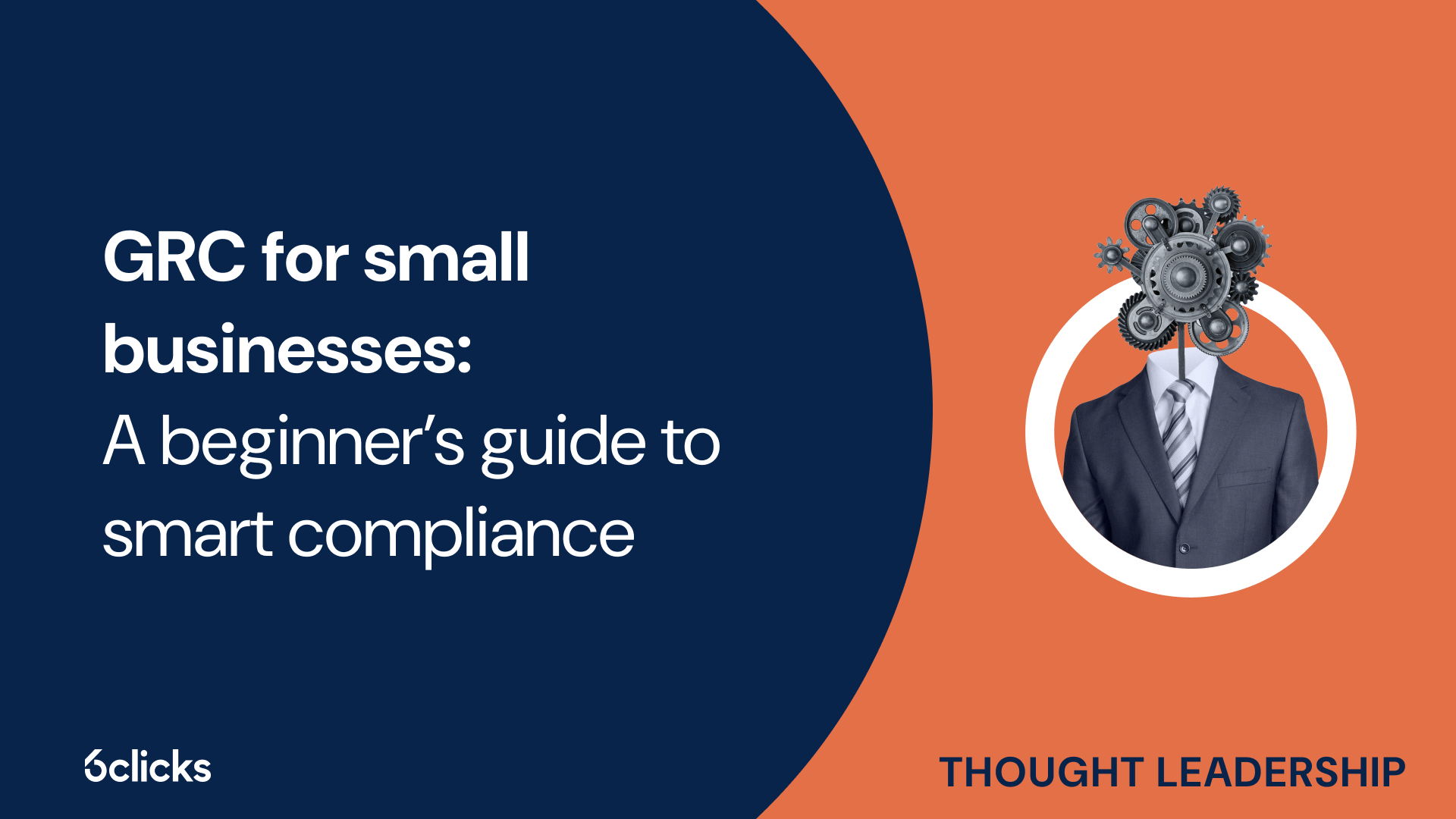
When it comes to governance, risk, and compliance (GRC), many small businesses assume it’s only a concern for large enterprises with sprawling operations and global exposure. But this misconception leaves them dangerously exposed. Mastercard's new survey of over 5,000 small and medium‑sized businesses across four continents found that 46% have experienced a cyberattack, and nearly one in five businesses that suffered an attack filed for bankruptcy or closed their doors.
In today’s threat-driven business environment, small businesses must demonstrate robust security practices to protect their operations, meet regulatory obligations, and earn customer trust. This blog explores the unique challenges smaller organizations face, practical strategies for embedding GRC into everyday operations, and how technology—particularly AI-powered solutions like 6clicks—can make enterprise-grade GRC achievable at a small-business scale.
What GRC means in a small business context

At its core, GRC stands for:
-
Governance – How decisions are made and how the organization is directed and controlled
-
Risk management – Identifying, assessing, and addressing threats to the business
-
Compliance – Meeting legal, regulatory, and contractual obligations, as well as industry standards that apply to the organization
For a small business, GRC might not mean building a dedicated compliance department. Instead, it’s about embedding these principles into day-to-day operations. That could mean:
-
Establishing policies for safeguarding customer and employee data
-
Ensuring contracts with suppliers and service providers include security obligations
-
Maintaining workplace safety standards
-
Following financial reporting and tax requirements accurately
Rather than treating GRC as a once-a-year project or “tick-box” exercise, small businesses can integrate it into daily workflows, making it easier to manage and more effective in protecting the business.
Common GRC challenges for small businesses
Small businesses have unique constraints when it comes to GRC. They face the same cyber threats, regulatory obligations, and reputational risks as bigger players, but the impact can be far more damaging for a smaller operation:
-
Limited budgets and staffing – Few can afford full-time compliance officers or large IT teams.
-
Knowledge and skills gaps – Regulations and standards can be complex, especially for sectors like finance, healthcare, and technology.
-
Fast-changing landscape – Cyber threats evolve quickly, and new compliance obligations emerge regularly.
-
Third-party dependency – Many rely heavily on cloud-based software, outsourced services, and supply chain partners — each introducing potential risks.
These challenges often lead to reactive rather than proactive approaches, where GRC is only addressed after an incident or audit finding.
Why prioritizing GRC makes business sense
While it may seem like another administrative burden, strong GRC practices deliver real benefits:

-
Avoiding costly disruptions – Compliance failures and cyber incidents can lead to fines, legal costs, and downtime.
-
Strengthening trust – Customers, investors, and partners want to know their data and interests are protected.
-
Improving efficiency – Standardizing processes reduces duplicated work and prevents errors.
-
Enabling growth – Meeting compliance requirements opens doors to new markets, larger contracts, and industry partnerships.
For small businesses, GRC isn’t just about avoiding risk; it’s also about creating opportunities.
Practical GRC strategies for small businesses
The key is to start small, focus on priorities, and build gradually. Effective GRC doesn’t have to mean complex frameworks and endless documentation. By focusing on a few high-impact areas, small organizations can build a solid foundation that protects their business.
Start by defining roles and responsibilities, identifying your key risks, and determining which regulations and standards apply to your business. From there, you can implement targeted strategies that make GRC manageable:

Centralize policies, procedures, and evidence
Once you’ve identified your key risks and compliance obligations, the next step is to establish clear policies and procedures that address them. Store all compliance documents, policies, and audit evidence in one secure location for easier access and updates. Leveraging technology, particularly a complete GRC solution like 6clicks, lets you centralize all data and manage risk, compliance, and audit activities in one platform. This creates a single source of truth, ensuring consistent, accountable, and streamlined workflows.
Conduct regular risk assessments
Regular risk assessments help you identify potential threats before they cause disruption. For small businesses, this means looking at areas such as cybersecurity, supply chain reliability, operational processes, and regulatory compliance. By evaluating the likelihood and potential impact of each risk, you can prioritize the ones that matter most. Using a platform like 6clicks streamlines this process with built-in assessment templates, automated scoring, and AI-powered insights, so you can make informed decisions and address issues before they escalate.
Implement controls and map to compliance obligations
Controls are the measures you put in place to reduce risk and meet compliance requirements — for example, enforcing strong passwords, encrypting data, or requiring two-person approval for large transactions. Once implemented, you can often map a single control to multiple frameworks (e.g., ISO 27001, GDPR, PCI DSS) to save effort and avoid duplication. 6clicks makes this process easier through AI automation, allowing you to identify overlapping requirements across frameworks and align your controls within seconds.

Train staff regularly
Ensure employees understand their compliance responsibilities through ongoing training. Hold regular sessions covering safe data handling, recognizing phishing attempts, reporting suspicious activity, and following workplace health and safety protocols.
Monitor and review continuously
Set up regular check-ins to assess whether controls are working and update them when regulations, technologies, or threats change. Run periodic internal audits to verify compliance, identify gaps, and ensure corrective actions are implemented promptly.
How automation and AI change the game for small business GRC
Manual GRC processes can be time-consuming and prone to oversight. Automation and AI help small businesses keep up without overextending their resources:
-
Automated risk assessments – Identify and evaluate risks faster, with consistent scoring and reporting.
-
Continuous control monitoring – Detect compliance gaps or control failures in real time.
-
AI-powered control mapping – Tools like Hailey AI map your existing controls to multiple frameworks instantly to identify gaps, saving hours of manual work.
-
Automated remediation – Easily generate risk treatment plans or issue remediation tasks with Hailey AI to enable prompt response to emerging threats.
With 6clicks, small businesses can harness these enterprise-level GRC capabilities without the enterprise price tag. Get full access to 6clicks’ GRC modules, including Hailey AI, and jump-start compliance with ready-made content tailored to widely used standards and regulations such as ISO 27001, GDPR, PCI DSS, and more.

By reducing manual effort and centralizing GRC activities, 6clicks helps small businesses protect themselves, stay compliant, and operate more efficiently.
Conclusion: Making GRC work for your business
For small businesses, governance, risk, and compliance don’t have to be complex or overwhelming. By focusing on the essentials — from identifying key risks and implementing the right controls, to training staff and reviewing processes regularly — you can build a GRC program that not only protects your business but also supports long-term growth.
With the right technology, these practices become easier, faster, and more cost-effective to manage. Platforms like 6clicks bring automation, AI, and pre-built compliance content together in one place, so you can achieve enterprise-grade GRC without the enterprise-level cost or complexity.
Get started with 6clicks
Ready to simplify and strengthen your GRC approach? Book a 6clicks demo and see how our platform can help your business stay secure, compliant, and resilient.


